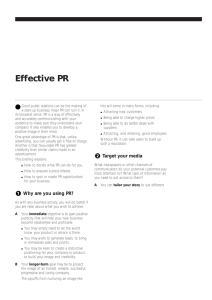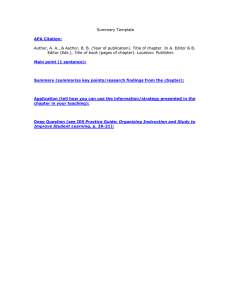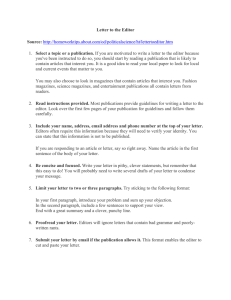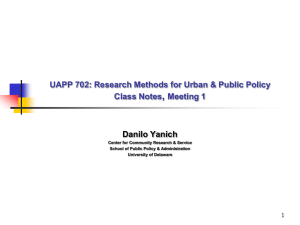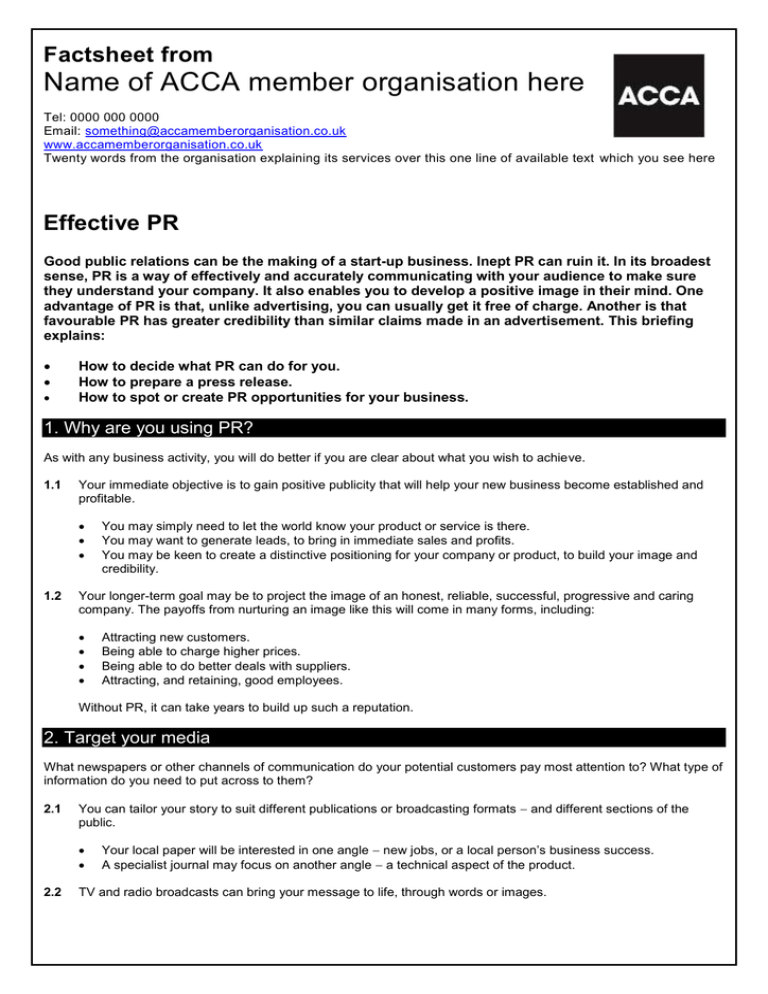
Factsheet from
Name of ACCA member organisation here
Tel: 0000 000 0000
Email: something@accamemberorganisation.co.uk
www.accamemberorganisation.co.uk
Twenty words from the organisation explaining its services over this one line of available text which you see here
Effective PR
Good public relations can be the making of a start-up business. Inept PR can ruin it. In its broadest
sense, PR is a way of effectively and accurately communicating with your audience to make sure
they understand your company. It also enables you to develop a positive image in their mind. One
advantage of PR is that, unlike advertising, you can usually get it free of charge. Another is that
favourable PR has greater credibility than similar claims made in an advertisement. This briefing
explains:
How to decide what PR can do for you.
How to prepare a press release.
How to spot or create PR opportunities for your business.
1. Why are you using PR?
As with any business activity, you will do better if you are clear about what you wish to achieve.
1.1
Your immediate objective is to gain positive publicity that will help your new business become established and
profitable.
1.2
You may simply need to let the world know your product or service is there.
You may want to generate leads, to bring in immediate sales and profits.
You may be keen to create a distinctive positioning for your company or product, to build your image and
credibility.
Your longer-term goal may be to project the image of an honest, reliable, successful, progressive and caring
company. The payoffs from nurturing an image like this will come in many forms, including:
Attracting new customers.
Being able to charge higher prices.
Being able to do better deals with suppliers.
Attracting, and retaining, good employees.
Without PR, it can take years to build up such a reputation.
2. Target your media
What newspapers or other channels of communication do your potential customers pay most attention to? What type of
information do you need to put across to them?
2.1
You can tailor your story to suit different publications or broadcasting formats and different sections of the
public.
2.2
Your local paper will be interested in one angle new jobs, or a local person’s business success.
A specialist journal may focus on another angle a technical aspect of the product.
TV and radio broadcasts can bring your message to life, through words or images.
2.3
A news item on local TV could get people talking about an unusual service you offer.
An interview on local radio can get people thinking about your product or service.
Consider the geographical location of the people you wish to reach. For example:
A complimentary write-up in a tourist guide could attract people to your pub from outside your area.
A mention on a specialist website could bring in enquiries from all over the world.
3. What does an editor need?
If you want editors to run your story, you must give them what they need news.
3.1
News is typically one of the following:
3.2
News that arrives too late is no good to anyone. Find out a publisher or broadcaster’s deadline for receiving
press releases.
3.3
New or novel.
Shocking or controversial.
Amazing or funny.
Directly important to readers.
Confidential or secret.
Concerned with famous people or places.
Submit your press release well in advance, unless it is a ‘hot’ news item.
Find out how editors prefer to receive news and press releases (eg by email, phone or post).
Editors are often happy to discuss ideas over the telephone. It can save time, and ensures you hit their
deadlines.
4. Routine PR opportunities
To get into the national press, a story about your business success has to be highly newsworthy. To get into a local
paper, or the trade press, it only needs to save the editor work and be interesting to local people or those working in
the industry.
4.1
Get ready, in advance, to announce a success when it happens. The subject of your press release could be:
The launch of a new product.
The opening of new premises.
Large or interesting (eg overseas) orders.
Staff appointments.
A milestone event eg the anniversary of your company or your 1,000th customer.
4.2
Some trade magazines have sections for this sort of announcement. Send appropriate information, making it
clear which section of the publication the information is for.
4.3
Better still, invite a trade journalist to the event in the first place.
5. Think of an angle
To the outside world, your product or service may seem deadly dull. Try to make a connection that links it to something
interesting.
5.1
Invite a local celebrity along (the mayor may appear for free) to open your new premises.
2
5.2
Offer prizes for milestone events (see 4.1).
5.3
Imagination can make all the difference.
5.4
A new restaurant researched the favourite dishes of famous people and put these celebrity meals on its
opening night menu. Both press and radio picked up the story.
A florist wrote a highly successful press release based on the traditional medicinal uses of the flowers in her
shop.
Think about the image you are promoting.
Your story about your encounter with a poisonous tropical spider may generate plenty of publicity. But it will
not lure many extra customers to your fruit shop.
6. Put out a press release
6.1
Get the names and email addresses of your target journalists or editors. Check the publication deadlines and
send your press release in plenty of time. Use ‘PRESS RELEASE’ as the subject heading.
6.2
If you are sending your press release by post, use your headed paper. Write ‘PRESS RELEASE’ across the
top of the page. Use double-spaced lines with wide margins, to leave room for editing and make the
journalist’s job easier.
Write an attention-grabbing headline, without being obscure or over-clever.
The headline should indicate what the press release is about. But if it is boring, the editor may not bother
reading further.
6.3
The opening paragraph must summarise the story and highlight the key points of interest to the people the editor
is aiming at.
6.4
Next, give some details. Put the most interesting information first, as the editor may not read the whole press
release. If you are launching a new product, the follow-on paragraphs should explain:
What is new about your product.
Its advantages.
Its applications who can use it for what?
Its details specification, price.
Who to contact for more information.
Limit your press release to about 300 words, with no more than 60 words per paragraph. Put additional
background and technical information in a ‘Note to Editors’ at the end.
6.5
Use short sentences and short words.
Avoid jargon unless you are writing for a technical magazine.
Always include some quotes in direct speech, as these spice up the material and are popular with editors.
Comment should always come from a named person, not your company.
Make your words easy to use, by matching the style of the publication or programme.
6.6
Below the text, put the writer’s name, address, email address, office and home telephone number, and the date.
6.7
Make sure the person named is available. Editors will lose interest if they cannot get hold of anyone.
Make contact with the publication or programme you are aiming for.
Find out the name of the journalist who is most likely to cover the story.
Send the press release and then phone to check that the journalist has received it.
3
7. Give them a photograph
An interesting picture will draw the journalist’s attention to your press release even if your story is not particularly
strong. If the photograph is published, it will catch the reader’s eye, too.
7.1
The photograph must be relevant.
7.2
Plan ahead.
How can you make the photo interesting? Think about the background, people, poses, products, props and
lighting.
Check what file format the photo should be sent in (if in doubt, use jpeg) and attach it to an emailed press
release. Make sure the image is good quality, but not so big that it takes a long time to download (a file of
around 1Mb will normally enable a publication to use it as they wish).
If your story catches an editor’s attention in advance, they may send their own photographer.
7.3
Include an explanatory caption which includes your company’s name and the names of anyone in the photo.
7.4
Pictures taken by a press photographer have a better chance of being published.
A press photographer will have an eye for the shots the media want.
Ask your local newspaper to recommend a good freelance photographer.
If the publication knows the photographer, journalists are more likely to look at your press release.
8. Other publicity ideas
The PR possibilities for an imaginative start-up business are endless.
8.1
Promote yourself as an expert.
8.2
Get to know the journalists who cover your industry. Offer them a training day.
8.3
Offer yourself for public speaking.
Phone up publications and broadcasts to offer your views on topical issues; participate in online forums and
write or comment on blogs; develop a social media presence..
Send ‘letters to the editor’.
Submit articles for publication, or offer amusing work stories to a newspaper’s business diary.
Join trade associations and local bodies.
Learn to work with local organisations.
Produce a newsletter for customers and staff and send copies to the local papers.
Suggest a local newspaper or radio competition and offer your products as prizes.
Help with or donate your product to a local charity.
Support careers evenings at local schools and colleges.
Sponsor a local event or sports team.
For a start-up, most publicity is good publicity.
9. Watch your back
PR can backfire. Journalists will write what they think makes a good story. They will often look for controversy, and the
first person they contact may be someone with the opposite view to you. Bad press coverage tends to focus on
complaints from customers or staff. Customers may claim to have been ripped off, and staff may protest about
dismissals or poor working conditions.
4
9.1
Be careful what you say.
9.2
Make it clear which of your employees are allowed to answer journalists’ questions.
Avoid ‘off the record’ comments, unless you already have a good relationship with the journalist.
Do not duck questions about controversial issues affecting your business. But do not be rushed into a
spontaneous reaction.
Check what the newspaper’s deadline is, construct your statement carefully, and respond promptly, within
the deadline. Do not lose the chance to tell your side of the story.
Evasive tactics may result in an article ending with ‘not available for comment’, which always looks furtive.
10. Will PR work for you?
The best form of PR is a satisfied customer who recommends your business to other people.
10.1 Ask yourself whether your time would be better spent building up your business and nurturing your reputation
with customers than putting effort into PR activities. Or can you achieve more by winning sales leads and honing
your image through PR?
10.2 If active PR has a role to play in your business, but you do not have the resources for your own campaign,
consider using a PR agency.
10.3 Look at what your customers read.
Could you feature in these publications? If the answer is yes, you may be missing a good opportunity if you
are not using PR.
11. Using a PR agency
11.1 Consider using an agency if your annual PR budget is greater than £15,000.
For smaller projects, you can employ freelance PR agents. Day rates can range from £300 to £1,000.
11.2 Choose an agency with relevant experience and contacts.
11.3 Provide a clear briefing on what you are trying to achieve.
Explain what makes your company and your products different.
11.4 Plan how the PR agency will work with your other promotional activities and agencies.
Be wary of agencies that see PR as the solution to every marketing need.
Heading for the wastebin
Editors say the ten most common mistakes in connection with press releases are:
1.
2.
3.
4.
5.
6.
7.
8.
9.
10.
Long, boring text with nothing to say.
Dull photos of products (with no people) or of rows of middle-aged men.
No quotes (again, people make papers).
Failure to think up any angles.
Good story, buried in paragraph four.
Failure to tailor the press release to the media it is being sent to.
Sending a press release about a business outside the circulation or broadcast area.
Missing the deadline.
Sending the press release to the wrong person or just to ‘The Editor’.
Spelling the journalist’s name incorrectly.
5
Further Help
Last reviewed 01.06.11
© Atom Content Marketing Ltd 2011. ISSN 1369-1996. All rights reserved. No part of this publication may be reproduced or transmitted without the
written permission of the publisher. This publication is for general guidance only. The publisher, expert contributors and distributor disclaim all liability
for any errors or omissions. Consult your local business support organisation or your professional adviser for help and advice.
6

